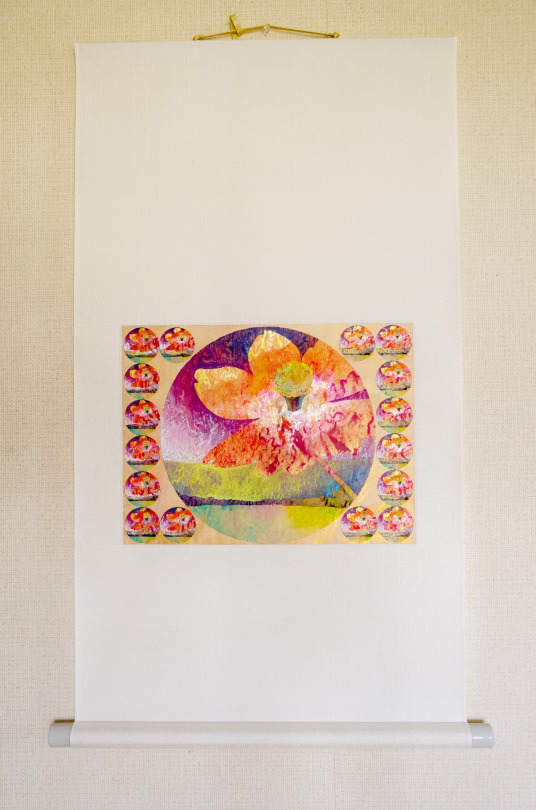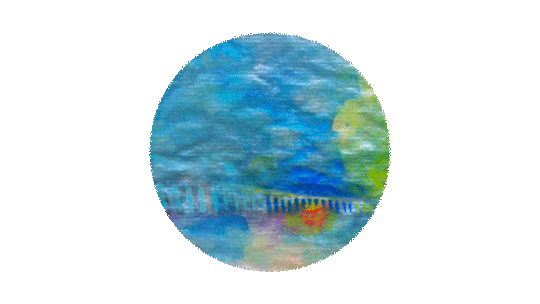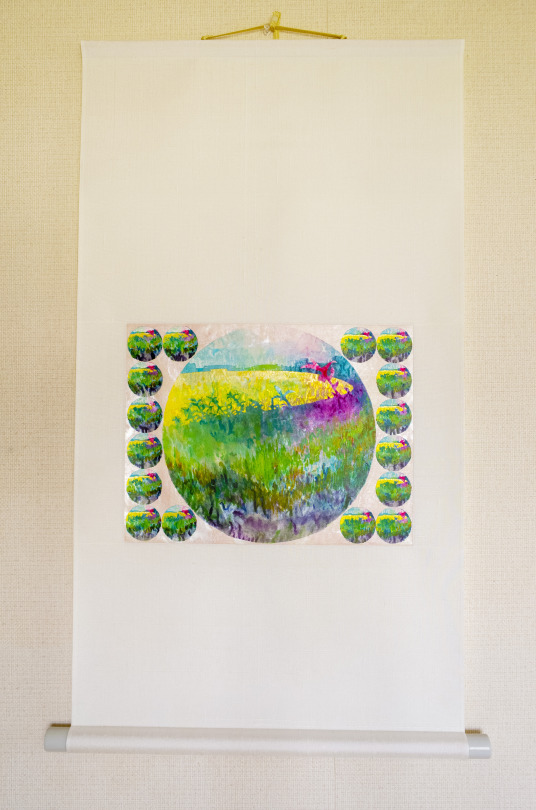#hanging_scroll
Text



観香 - 花の惑星
/ Viewing Aromas - Floral Planet
[Motion Painting]
紙本着彩、額装、映像に変換(4秒ループ)
/ Acrylic colours on Japanese paper, hanging scroll, convert to movie (4 seconds loop)
270×360mm (本紙 / image), 890×540mm (総丈 / hanging scroll)
2022
調香 / Brending Aromas - 8th Apr 2018
於 蟠龍寺、目黒 / at Banryuji, Tokyo
香りのレシピ / Recipe of the Aromas
ラベンダー×2 / Lavender*2
フランキンセンス / Frankincense
ローズマリー×2 / Rosemary*2
ゼラニウム / Geranium
ジュニパーベリー×2 / Juniper berry*2
ブルーロータス×2 / Blue Lotus*2
#paintings #2022 #japanese_paper #motion_painting #viewing_aromas #観香 #hanging_scroll
https://www.instagram.com/p/C4hmniHLp_6/
2 notes
·
View notes
Text
Hall of Shadows Critical Review Report
Hall of Shadows: An exploration of Australian war crimes and missing information
“I am not going to pass any judgment on the policy of devastating the country. I obey orders, and perhaps it is a wise plan.”
-RL Wallace, The Australians at the Boer War
WHAT:
Hall of Shadows is a mixed media exploration of war crimes by Australians during conflicts in Afghanistan as detailed by The Brereton Report, an extensively redacted investigation into the deaths of civilians and prisoners. Utilising wet plate collodion tintypes and printed materials taken from digital media, Hall of Shadows focuses on creating a visual mirror to our society to see the far-reaching human cost of these war crimes. The work is about reflecting upon the special operations soldiers who committed the crimes, the political and civil authorities who placed them in these situations on behalf of the civilian population and the media who report on the crimes and the report itself.
The work consists of a grid of 15 wet plate collodion tintype still lifes of toy soldiers in miniature dioramas constructed of wooden blocks, along with four A1 sized newsprint banners in various states of use and disrepair. The tintypes are an echo of, and inspired by, the Hall of Memory at the Australian War Memorial in Canberra, which houses 15 stained glass windows, each with a word that is a quality of Australians at war. The form of the banners was influenced by Chinese hanging scrolls, intended for short-term news and propaganda dissemination. The materiality, plasticity, texture, and imperfections of the toy soldiers I had used as subjects in creating the still lifes for my wet plates was underscored to draw the viewer's attention to in the banners. The banners are images taken directly from the pages of the heavily redacted report overlaid with pictures of plastic toy soldiers.
Both works are meant to evoke reflection in viewers. Where the original stained glass windows are lushly coloured and use a Deco font, the tintypes are monochrome and the words scratched into the surface of the metal. The banners are printed on flimsy, disposable newsprint, and with much of the text unreadable.
WHY:
Australia has an ambivalent relationship with military engagement. The Department of Veteran Affairs (DVA) estimates that approximately 2% of the population are veterans, yet there appears to be a disproportionate emphasis, even a reverence, for military action in popular culture. The large sections of military history and accounts which glamourise the military found in books stores reveals something about the popularity and hunger for information about this segment of our society. But much like sports figures whose poor or inappropriate behaviour is overlooked or excused, soldiers and military action are often elevated to positions above critique or reflection or only examined on Anzac Day then forgotten until the next year.
This work was created in hope of raising some questions for the viewer:
Who am I in relationship to these people and events?
How does my image of this history correspond to lived realities?
What agency, if any do I have relative to these events?
Factors that emerged during the creation of the work included the fact that the greater the temporal distance became between the report’s release (November 2020) and the present, the more of a collective and communal shrug there seemed to be about these crimes and any consequences for those who committed them. This seeming public lack of interest led towards processes and materials that were disposable, recyclable, non-permanent and dismissible, just as the acts which were the genesis of the report and the public response to it appeared to be a part of an ever-churning news cycle. The work was created to be both fixed in history with elements of discard and disposability.
WHO:
This work occurs and is informed by a number of photographic, artistic, military and societal communities. Photographically, a historical process is employed in the tintypes and more modern, digital-descended processes for the scrolls. The incorporation of text to both sets of images is relative to the work of Duane Michals, while wet plate photography has been employed extensively by Sally Mann. The use of miniature diorama and tableaus akin to David Levinthal’s work using toy soldiers and dolls was an important example of how applying good technical skills to small subjects can heighten the impact of images. His series Hitler Moves East is a slightly more abstracted work emulating black and white war photographs contemporary to the historical period of 1939-1945.
Returning to the work of Hiroshi Sugimoto and his photographs of diorama’s in museums also proved inspirationally fruitful. Sugimoto’s concept of photographing a faux re-creation of a time, place and event, had significant overlap and relationship to the work in creating the miniature dioramas as backgrounds I was staging seemed particularly relevant to my investigations. Of particular interest and insight is Sugimoto’s observation that “However fake the subject, once photographed, it’s as good as real.”
Roy Lichtenstein’s pop art, particularly, his work Whaam! seemed to share a print-pixelated, quasi-comic book quality the the scrolls/banners. While it initially felt that a connection might exist to the disposable aspect of Lichtenstein’s work, these images seemed less satisfying at communicating more realistic figures of the toy soldiers. The hope for more identification with soldier’s as the subject, rather than objectification simply wasn’t achieved, and so a more realist approach was adopted. (Note: the Lichtenstein Foundation’s website seems abandoned at this point and is available only through internet archives. I include his citation in Wikipedia for reference purposes.
Liz Wells observations about the truth or non-truth and historical uses of photography in commenting upon war continued to be a touchstone. Especially her observation about the uses of photography in establishing and reinforcing communal sentiments about war. “[T]here are no unequivocally great photographs of war, only those that structure or re-enforce feelings already extant within a particular culture.”
Additionally, the work of Alexander Rodchenko was examined, particularly the shift in his work from documentary photography to its use as propaganda. Rodchenko had good reason to make this turn: survival. As the young Soviet state went from photographic and cinematic playground to a more authoritarian state, photographers found ways to either praise Stalin and the new state or perish. In my work I was seeking to neither laud soldiers nor condemn them, but rather, hold up a mirror to the viewer to examine their own conceptions, pre-conceptions and mis-conceptions about military action and those who carry out the policies of the state, especially in ambiguous environments.
How:
The work was realised through a close reading of the available documents, reflection on my own experience in the Afghanistan theatre of operations, and testing with select trusted voices about the efficacy of whether intended messages were being communicated. This last was a necessary counter-balance to a body of work that was grounded deeply in personal experience. The challenge in this path is getting lost in a personal echo chamber where what seems obvious to the creator is completely unreadable to the viewer. Listening to my supervisor, peers and close friend’s readings of the work was exceptionally helpful in maintaining this balance.
With regard to the wet plates, arranging and mounting the images as a call/response to the sacred and mythological tones of the stained glass windows in Canberra was done as a means to open a door to reflection about their own position relative to military engagement. The limitations and ‘defects’ inherent in wet plates was also a desired element of the work. Just as no plate can be clinically ‘perfect,’ so no military action is without casualties.
The later-developed hanging scroll banners afforded an opportunity to use their materiality as fragile, disposable objects that, in their physical structure, reflected the ephemerality of the impact of the news cycle on our collective attention span. This, in turn, allowed for them to develop as a seperate, unified work on their own, standing along side, but different from the wet plate works.
Best practices for health and safety, including mental well-being, were followed throughout the creation of the work.
Test/Speculative Images:
Finalised plate samples, prior to mounting & framing:
Bibliography
Batchen, Geoffrey. (2004.) Forget Me Not: Photography & Remembrance. 1st ed., New York: Princeton Architectural Press.
Laurent, Olivier. (June 15, 2015.) “A Photographer Turns Real-Life Soldiers Into Toys.” Time. Accessed March 10, 2021. time.com/3911329/a-photographer-turns-real-life-soldiers-into-toys/.
Levinthal, David. (1972-75.) “Hitler Moves East.” David Levinthal. Accessed May 28, 2021. davidlevinthal.com/artwork/hme.html.
Sugimoto, Hiroshi. (1994.) “Diorama.” Hiroshi Sugimoto. Accessed May 28, 2021. www.sugimotohiroshi.com/new-page-54.
Wells, Liz. (2015.) Photography: A Critical Introduction. 5th ed., New York: Routledge.
Wikipedia. (2004.) Hanging Scroll. Accessed May 30, 2021. en.wikipedia.org/wiki/Hanging_scroll.
Wikipedia. (2002.) Roy Lichtenstein. Accessed May 28, 2021. en.wikipedia.org/wiki/Roy_Lichtenstein.
Young, Marnin. (2016.) “Photography and the Philosophy of Time: On Gustave Le Grays Great Wave, Ste.” nonesite.org. Accessed March 18, 2021. https://nonsite.org/photography-and-the-philosophy-of-time/.
Zax, Talya. (2021.) “How Freedom Turned to Propaganda in Soviet Photography.” The Forward. Accessed May 28, 2021. forward.com/culture/322220/how-the-soviet-union-used-photography-as-propoganda/.
0 notes
Text



観香 - 天使のかけっこ
/ Viewing Aromas - Angel played a Race [Motion Painting]
紙本着彩、額装、映像に変換(4秒ループ)
/ Acrylic colours on Japanese paper, hanging scroll, convert to movie (4 seconds loop)
360×270mm (本紙 / image), 960×450mm (総丈 / hanging scroll)
2022
調香 / Brending Aromas - 8th Apr 2018
於 蟠龍寺、目黒 / at Banryuji, Tokyo
香りのレシピ / Recipe of the Aromas
クラリセージ×2 / ClarySage*2
ベルガモット×3 / Bergamot*3
ブルーロータス×5 / Blue Lotus*5
#paintings #2022 #japanese_paper#motion_painting #viewing_aromas #観香 #hanging_scroll
https://www.instagram.com/p/C3-KBp3vRXa/
https://gallery-aquarelles.stores.jp/items/65e3a6125b1e9110b9679321
0 notes
Text



観香 - 香りの泉
/ Viewing Aromas - Fountain of Aromas [Motion Painting]
紙本着彩、額装、映像に変換(4秒ループ)
/ Acrylic colours on Japanese paper, hanging scroll, convert to movie (4 seconds loop)
270×360mm (本紙 / image), 890×540mm (総丈 / hanging scroll)
2022
調香 / Brending Aromas - 11th Apr 2018
於 K氏邸、東京 / at K‘s house, Tokyo
香りのレシピ / Recipe of the Aromas
ニオイコブシ×6 / Nioikobushi(Magnolia Salicifolia)*6
小夏×5 / Konatsu(New Summer Orange)*5
トンカビーンズ×3 / Tonka Beans*3
ハッカ / Hakka(Japanese mint)
ゼラニウム / Geranium
パチュリ / Patchouli
#paintings #2022 #japanese_paper #motion_painting #viewing_aromas #観香 #hanging_scroll
https://www.instagram.com/p/C21Vw-SrlMt/
https://gallery-aquarelles.stores.jp/items/65c7e9904fdf6e07a0647a74
0 notes
Text
Chinese Hanging Scrolls
The ‘banners’ which are part of Hall of Shadows were initially imagined as announcing the tintype portion of the work while emphasising two things: 1) the toy and plastic nature of the soldier figures and 2) the large swaths of the report which appear in print as redacted, blacked out, unreadable to anyone outside the government. I combined these two features and wanted them to be large and visible. The influence of Chinese hanging scrolls as both news-carrying and propagandistic was an added bonus.
https://en.wikipedia.org/wiki/Hanging_scroll
0 notes